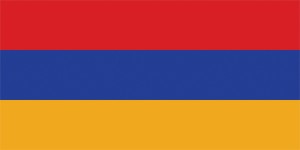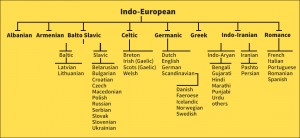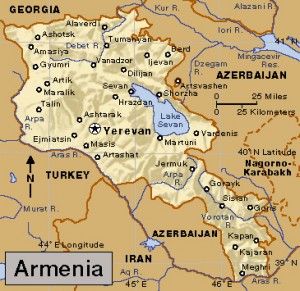Language Monday: Armenian
April 23, 2018
Armenia is a rugged country of about 3 million people in the Caucasus Mountain region of southwestern Asia. Present-day Armenia and what is now eastern Turkey make up historic Armenia, the original homeland of the Armenian people. About 7 million people speak the Armenian language worldwide. Armenian has its own alphabet, and it shares few similarities with other modern languages. But like most of the languages of Europe, western Asia, and India, Armenian belongs to the Indo-European language family. Today’s Armenian language also shares some words with Greek, old dialects of Aramaic, and the Iranian language family.

The flag of Armenia, seen here, flies over roughly 3 million Armenian speakers. Credit: © T. Lesia, Shutterstock
The Armenian language was first spoken more than 3,000 years ago. Armenians call their language Hayeren or Haieren, and they refer to themselves as Hay. The first evidence of written Armenian dates to about A.D. 405, when the scribe Mesrop Mashtots created an alphabet to translate the Christian Bible into the Armenian language. The alphabet that Mashtots created borrows some characters from Greek and Syriac—a dialect of the Aramaic language. The Classical Armenian alphabet contained 36 phonemes (distinct sounds) represented by 28 consonants and 8 vowels. Two additional letters later joined the alphabet to accommodate sounds that had not been part of the language as it was first written. The alphabet’s punctuation marks also differ from other languages.
In the early A.D. 300′s, Armenia became the first nation to adopt Christianity as its state religion. Armenians later spent centuries under the control of the Persian and Ottoman (Turkish) empires, and the Armenian language borrowed words from these occupiers. Modern Armenian began taking its present form between the 1400’s and 1600’s. By the mid-1800’s, the language had two main dialects—Eastern and Western Armenian. The dialects had differences in pronunciation and grammar, but many speakers could understand both. Classical Armenian, called Grabar, remained the primary language used for writing into the 1800’s. But modern Armenian, known as Ashkharhabar in the Eastern dialect and Ashkharhapar in Western, soon became standard for both speaking and writing.

Click to view larger image
Armenian belongs to the widespread Indo-European language family. Credit: WORLD BOOK diagram
By 1915, the Ottoman Empire had driven most Armenians out of western Armenia, which became eastern Turkey. In an event called the Armenian Genocide, more than one million Armenians were killed or died from starvation or lack of water. Eastern Armenia later became part of the Soviet Union. Armenia remained under Soviet control until 1991, when the people voted to become an independent nation. Today, Eastern Armenian is Armenia’s official language, and it is also spoken by people of Armenian descent who live in nearby Iran, Azerbaijan, and Georgia. Many scholars consider Western Armenian an endangered language. It is spoken mainly by Armenians who remain in Turkey.



